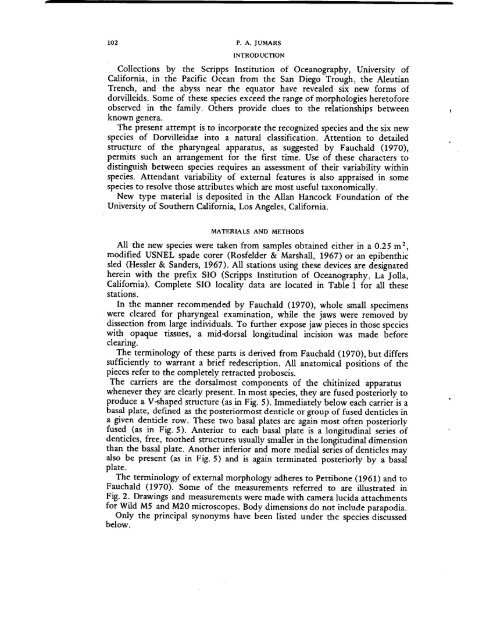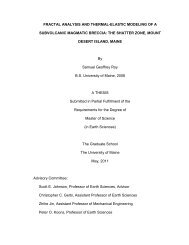Jumars, P.A. - University of Maine
Jumars, P.A. - University of Maine
Jumars, P.A. - University of Maine
Create successful ePaper yourself
Turn your PDF publications into a flip-book with our unique Google optimized e-Paper software.
1 0 2 P. A . JUMARS<br />
INTRODUCTION<br />
Collections by the Scripps Institution <strong>of</strong> Oceanography, <strong>University</strong> <strong>of</strong><br />
California, in the Pacific Ocean from the San Diego Trough, the Aleutian<br />
Trench, and the abyss near the equator have revealed six new forms <strong>of</strong><br />
dorvilleids . Some <strong>of</strong> these species exceed the range <strong>of</strong> morphologies heret<strong>of</strong>ore<br />
observed in the family . Others provide clues to the relationships between<br />
known genera .<br />
The present attempt is to incorporate the recognized species and the six new<br />
species <strong>of</strong> Dorvilleidae into a natural classification . Attention to detailed<br />
structure <strong>of</strong> the pharyngeal apparatus, as suggested by Fauchald (1970),<br />
permits such an arrangement for the first time . Use <strong>of</strong> these characters to<br />
distinguish between species requires an assessment <strong>of</strong> their variability within<br />
species . Attendant variability <strong>of</strong> external features is also appraised in some<br />
species to resolve those attributes which are most useful taxonomically .<br />
New type material is deposited in the Allan Hancock Foundation <strong>of</strong> the<br />
<strong>University</strong> <strong>of</strong> Southern California, Los Angeles, California .<br />
MATERIALS AND METHODS<br />
All the new species were taken from samples obtained either in a 0 .25 m 2 ,<br />
modified USNEL spade corer (Rosfelder & Marshall, 1967) or an epibenthic<br />
sled (Hessler & Sanders, 1967) . All stations using these devices are designated<br />
herein with the prefix SID (Scripps Institution <strong>of</strong> Oceanography, La Jolla,<br />
California) . Complete SIO locality data are located in Table 1 for all these<br />
stations .<br />
In the manner recommended by Fauchald (1970), whole small specimens<br />
were cleared for pharyngeal examination, while the jaws were removed by<br />
dissection from large individuals . To further expose jaw pieces in those species<br />
with opaque tissues, a mid-dorsal longitudinal incision was made before<br />
clearing .<br />
The terminology <strong>of</strong> these parts is derived from Fauchald (1970), but differs<br />
sufficiently to warrant a brief redescription . All anatomical positions <strong>of</strong> the<br />
pieces refer to the completely retracted proboscis .<br />
The carriers are the dorsalmost components <strong>of</strong> the chitinized apparatus<br />
whenever they are clearly present . In most species, they are fused posteriorly to<br />
produce a V-shaped structure (as in Fig . 5) . Immediately below each carrier is a<br />
basal plate, defined as the posteriormost denticle or group <strong>of</strong> fused denticles in<br />
a given denticle row . These two basal plates are again most <strong>of</strong>ten posteriorly<br />
fused (as in Fig . 5) . Anterior to each basal plate is a longitudinal series <strong>of</strong><br />
denticles, free, toothed structures usually smaller in the longitudinal dimension<br />
than the basal plate . Another inferior and more medial series <strong>of</strong> denticles may<br />
also be present (as in Fig . 5) and is again terminated posteriorly by a basal<br />
plate .<br />
The terminology <strong>of</strong> external morphology adheres to Pettibone (1961) and to<br />
Fauchald (1970) . Some <strong>of</strong> the measurements referred to are illustrated in<br />
Fig. 2. Drawings and measurements were made with camera lucida attachments<br />
for Wild M5 and M20 microscopes . Body dimensions do not include parapodia.<br />
Only the principal synonyms have been listed under the species discussed<br />
below .
















